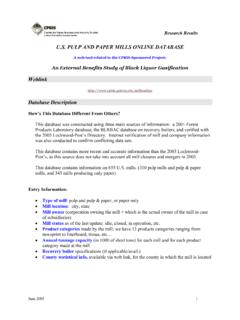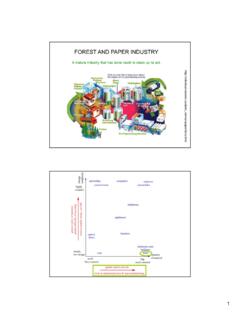Transcription of ITP Forest Products: Energy and Environmental Profile of ...
1 Energy AND Environmental Profile OF THE pulp AND paper industry Industrial Technologies Program Wood chips from pulp and paper mills Willow tree research plots, Tully, New York Wood gasifier demonstration, Burlington, Vermont paper drying steam cans, awaiting shipment December 2005 Energy and Environmental Profile of the pulp and paper industry December 2005 Prepared by Energetics Incorporated Columbia, Maryland for the Department of Energy Office of Energy Efficiency and Renewable Energy Industrial Technologies Program Acknowledgments This report was written by Energetics Incorporated in Columbia, Maryland. It was prepared under the general direction of the Department of Energy s Industrial Technologies Program with oversight by Isaac Chan and Drew Ronneberg.
2 The principal authors of the report are Melanie Miller, Mauricio Justiniano, and Shawna McQueen, with technical and editorial contributions made by Joan Pellegrino and Tracy Carole, of Energetics Incorporated. External technical reviews of the report were provided by the following individuals associated with the Forest products industry : Elmer H. Fleischman Idaho National Laboratory Irene A. Kowalczyk MeadWestvaco Corporation Michael A. Roberts Roberts Group LLC Benjamin A. Thorp, III industry Consultant Paul M. Tucker International paper Energy and Environmental Profile of the pulp and paper industry i Table of Contents 1. Overview ..1 2. pulp and paper Mills ..15 3. Wood 4. Pulping ..27 5. Kraft Chemical 6. 7. Papermaking ..63 8. Supporting Systems ..73 9. The Forest Biorefinery ..79 Bibliography ..83 Energy and Environmental Profile of the pulp and paper industry ii Tables and Figures 1 Overview Snapshot of the paper and Allied Products Sector (2003).
3 2 Production of paper and Paperboard Products (2003).. 2 Total paper and Paperboard Production by 2 The Cyclical Nature of the paper and Allied Products Sector in Relation to GDP, Total Shipments, Capital Expenditures, and Capital Intensity .. 3 paper and Allied Products Ratio of R&D Expenditures to Net Revenues .. 4 Energy Use by Sector .. 5 2000 Energy Use by Fuel for paper 6 Energy Intensity Trends for paper Manufacturing .. 6 Use of Fuel and Energy by pulp , paper , and Paperboard (1972 and 2000) .. 7 Federal Regulations Affecting paper Manufacturing .. 9 National Ambient Air Quality Standards .. 10 Most-Emitted Hazardous Air Pollutants from pulp and paper Mills .. 10 Summary of Clean Water Act Requirements (as of 1998) .. 11 Anticipated Reduction in Pollutants from pulp and paper Mills under EPA's Cluster 12 Projected Cost of Compliance for Selected 13 Recovered paper Utilization in paper /Paperboard Production .. 13 Carbon Emissions from Combustion of Fuels in pulp and paper .
4 14 2 pulp and paper Mills Major paper Manufacturing Processes .. 15 Integrated pulp and paper Making Process .. 16 Estimated Energy Use by Process ..17 Heating Value of Selected Wood and Waste Fuels .. 18 Summary of Environmental Aspects of Wood Preparation Processes .. 18 Summary of Environmental Aspects of Pulping 19 Summary of Environmental Aspects of Kraft Chemical 20 Summary of Environmental Aspects of pulp Bleaching .. 20 Summary of Environmental Aspects of the Papermaking Process .. 21 Summary of Environmental Aspects of Wastewater Treatment .. 21 3 Wood Preparation Wood Consumption by Pulping Process and Species .. 23 Flow Diagram for Wood Preparation .. 24 Average Energy Intensities of Wood Preparation 25 Effluent Analysis for Wet Drum and Hydraulic Debarkers .. 26 4 Pulping Typical Compositions of North American Woods .. 27 General Classification of Pulping Processes .. 28 Comparative Characteristics of Kraft vs. Sulfite Pulping Processes.
5 29 Sample of pulp Mills by Geographical Region .. 29 Kraft Pulping Process .. 30 Sulfite Pulping 32 General Characteristics of Major Mechanical Pulping Processes .. 33 Energy and Environmental Profile of the pulp and paper industry iii Semichemical Pulping 34 Two Loop Deinking System for High-Grade Writing and Printing paper 36 Average Energy Intensities of Pulping Processes .. 37 5 Kraft Chemical Recovery Kraft Chemical Recovery Flow Diagram .. 42 Evaporation of Black Liquor .. 43 Green Liquor Preparation .. 45 Causticization of Green Liquor to Prepare White Liquor (Recovered Chemicals) .. 45 Lime Reburning and Recovery (Calcining).. 46 Average Energy Intensities of Kraft Chemical Recovery 48 Air Emission Factors for Kraft Chemical Recovery .. 49 6 Bleaching ISO Brightness Levels of Unbleached 51 Two-Stage pulp Brightening Process .. 52 Chemical pulp Bleaching 53 Chlorine Dioxide (D) 54 Alkaline Extraction (E) 55 Oxygen (O) Stage.
6 55 Hypochlorite (H) Stage .. 56 Ozone (Z) 57 Oxygen-Reinforced Alkaline Extraction (EOP) Stage .. 57 Hydrogen Peroxide (P) Stage .. 58 ECF Four Stage [OD(EOP)D] Bleaching Sequence .. 59 Average Energy Intensities of Bleaching 61 BOD of Softwood Kraft pulp Bleaching 62 Color of Softwood Kraft pulp Bleaching Effluent .. 62 Typical AOX Values for Kraft pulp Bleaching Effluent .. 62 7 Papermaking Typical Papermaking Flow 63 Wet-End Chemicals and Mineral Additives .. 64 Papermaking Machines in the United States by Type (2000) .. 65 Fourdrinier 65 Diagrams of Several Types of Twin Wire Formers .. 66 Energy Consumption in Papermaking .. 70 8 Supporting Systems Fuel Distribution in paper Manufacture .. 73 Boiler Fuel Efficiency .. 73 Major Types and Sources of Air Pollutants in pulp and paper Manufacture .. 75 Air Pollution Control Equipment .. 76 Regulated Effluent Characteristics .. 77 Common Water Pollutants from pulp and paper Processes.
7 77 9 The Forest Biorefinery Components of the Forest Biorefinery .. 79 Potential Products from Residuals and Spent Pulping Liquors .. 80 Energy and Environmental Profile of the pulp and paper industry iv Energy and Environmental Profile of the pulp and paper industry v Foreword The Department of Energy s Industrial Technologies Program (DOE/ITP) works with industry to develop technology partnerships and support collaborative R&D projects that enhance Energy efficiency, competitiveness, and Environmental performance. In 1996, DOE/ITP began work on a series of Energy and Environmental profiles on a number of basic industries that are vital to the economy but also very Energy -intensive. Though the profiles are intended primarily to better inform collaborative industry -DOE R&D planning, they also provide a valuable resource that can be widely used by many others who are not directly involved in these efforts.
8 Through these profiles, research managers, policy makers, industry analysts and others can gain a general perspective of industrial Energy use and Environmental impacts. The profiles do not attempt to recreate sources that already exist; rather, they provide a snap shot of the industry and a source of references on the topic. The primary advantage of the profiles is that they synthesize into a single document information that is available in many different forms and sources. Aggregated data for the entire industry as well as data at the process level is presented according to major unit operations. Data is obtained from the most currently available public sources, industry experts, and governmental reports. Prior to publication, profiles are reviewed by those working in the industry , trade associations, and experts in government and the national laboratories. To date, Energy and Environmental profiles have been published for the aluminum, steel, chemicals, petroleum refining, metal casting, glass, pulp and paper , and supporting industries ( , welding, heat treating, powder metallurgy).
9 Energy and Environmental Profile of the pulp and paper industry vi Energy and Environmental Profile of the pulp and paper industry 1 The Forest Products industry is comprised of paper Manufacturing (NAICS* 322) and Wood Product Manufacturing (NAICS 321). This report, Energy and Environmental Profile of the pulp and paper industry , addresses the largest and most Energy intensive of the two the paper Manufacturing sector. paper manufacturing includes pulp mills, papermaking plants, and integrated mills ( pulp and papermaking at same facility). *North American Industrial Classification System 1 Overview The paper Manufacturing Sector The United States is the world s leading producer, consumer, and exporter of pulp , paper , and paperboard products. The nation as a whole produces 28% of the world s pulp and 25% of its paper , with three of the world s five largest paper and Forest products companies based here (Paperloop 2003).
10 The United States also has the highest per-capita consumption of paper worldwide at 714 pounds per capita in 2001, compared to less than 244 pounds in Europe and 101 pounds in Asia (Paperloop 2003). paper Industries are Integral to the Economy paper manufacturing includes the processing of wood, recovered paper and paperboard, and other cellulose fibers into thousands of end-use products (MGH 1999). It is comprised of pulp mills, dedicated paper production facilities, and integrated mills that include both pulp processing and paper manufacture. The paper manufacturing sector is an integral part of the economy, shipping nearly $160 billion in products every year and employing more than 500,000 workers. paper manufacturing represents some of the world s largest installed production capacity, and is the most capital-intensive industry in the manufacturing sector. The sector is very diverse, with seventeen different industries using a variety of pulping processes and hundreds of different grades of paper to manufacture a myriad of products.



















